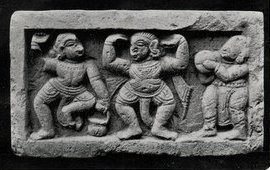It is now accepted by all that the modern age in Assamese literature starts from the beginning of the British regime in Assam in the nineteenth century. We can take 1826 as the landmark, as the Treaty of Yandabu singed in that year brought Assam under the rule of the East India Company. When the Burmese and the East India Company between  them settled the political state of Assam, the King Swargadeo was not consulted. The common people did not seem to mind the loss of political liberty. The population gradually settled down to normal conditions. It appears that people love peace and security for which they are often prepared to sacrifice their liberty. We can imagine from some writings of the nineteenth century that the common people generally welcomed and accepted the British rule as it rid them of the atrocities, internal and external, that they had suffered over several decades. Under the new regime at least they were no longer Karis and Paiks that is, landserfs. The people, both high and low, could see and appreciate the might of the British lion. It is true the British came with the declared object of driving away the hated Burmese and protecting ‘the holy cow and the Brahmin’, but they stayed on. The common people did not object. A few patriots thought otherwise, but they were systematically silenced by the Raj. The patriots did not get broad-based popular support required for an effective uprising. Not only the masses but also the educated minority supported the new regime and generally co-operated with it, hoping thereby to better their conditions.
them settled the political state of Assam, the King Swargadeo was not consulted. The common people did not seem to mind the loss of political liberty. The population gradually settled down to normal conditions. It appears that people love peace and security for which they are often prepared to sacrifice their liberty. We can imagine from some writings of the nineteenth century that the common people generally welcomed and accepted the British rule as it rid them of the atrocities, internal and external, that they had suffered over several decades. Under the new regime at least they were no longer Karis and Paiks that is, landserfs. The people, both high and low, could see and appreciate the might of the British lion. It is true the British came with the declared object of driving away the hated Burmese and protecting ‘the holy cow and the Brahmin’, but they stayed on. The common people did not object. A few patriots thought otherwise, but they were systematically silenced by the Raj. The patriots did not get broad-based popular support required for an effective uprising. Not only the masses but also the educated minority supported the new regime and generally co-operated with it, hoping thereby to better their conditions.
Against this background, the impact of the West was felt in Assam. For a long time in the past the British had kept an eye on the trade and natural resources of Assam. Late in the eighteenth century an English man prepared an account of Assam from information smuggled out. Now on the wake of the British rule came a number of British soldiers, administrators, prospectors, explorers and American missionaries. From the missionaries and others who kept touch with the masses, the common people heard about the lands lying far away and peoples living in lands lying beyond the vague ‘seven seas and thirteen rivers’. The isolation of the cultural life of the Assamese was broken.
The British saw to it that Assam remained merely a supplier of raw material and labour. On the labour front the British Capitalists failed, because the Assamese just released from the Kari-paik serfdom were not prepared to barter their freedom for indentured labour in the tea gardens and elsewhere. The British systematically discouraged the growth of local capital, and initiative in trade and industry. Assam was industrialised in a fashion, but the local people had no say in the matter. Inspite of the exhortations of Anandaram Dhekial Phukan, himself a member of a mercantile family and the efforts of the shrewd patriot, Maniram Dewan, the Assamese people did not generally come forward to make use of Western Science and technology. The Assamese elite were fascinated by the richness of English literature. The Assamese renaissance that we see in the nineteenth century was primarily a literary and moral movement. It was felt that literature would, in some intangible way, improve the condition of Assam and her people. Incidentally this kind of thought helped in the growth and development of modern Assamese prose.
The British introduced the Western type of secular education in Assam. The first English school was established at Guwahati in the year 1934. The Assamese intelligence might be seen working at Government offices, but many of them kept English at a safe distance. They were afraid of losing their castes if they read English. For them Bengali was the window on the world. Hem Chandra Barua, the writer of the first authoritative dictionary of Assamese had to learn English surreptitiously from the Sibsagar missionaries. Gradually the advantage of English education came to be appreciated. Young and ambitious students started going to Calcutta for higher education. And these students brought in the direct impact of the West to Assamese literature.
Hem Barua has rightly called the years between Yandabu and the publication of Jonaki (1889) a period of transition for Assamese literature. From many sides, it was a critical period for the growth and development of both modern Assamese literature and language. In the early years of the British rule, Assamese continued to be used in the primary schools and offices. But in 1836, it was replaced by Bengali for certain administrative reasons. It must be admitted that the educated minority could read and write Bengali. Some historians believe that Bengali domination started much earlier in the Ahom court itself. Haliram Dhekial Phukan wrote an Assam history in Bengali. Maniram Dewan’s writings were a curious mixture of Assamese, Bengali and Parsi. So was the interesting diary of Harakanta Barua, Sadar Amin. Yet the displacement of Assamese by Bengali was a serious set-back. Bengali continued till 1874 when after years of representations made by the missionaries and local gentlemen (both Assamese and Bengali), Assamese was restored to its former position. The Assamese language did not disappear and the set-back helped it in a number of ways. Something new occupied the Assamese mind now- a search for an identity. The elite looked back and looked forward. They found a new goddess and called her Ai Asom (mother Assam). Even in the meager literature of the period of transition, we find some patriotic writings. It is something which we hardly get in the literature of the Ahom age except of course in the ‘Buranji’s’. And this search for identity has given us song, like “O mor Aponar Desh” (Bezbaruah) and “Chira Chenehi Mor Bhasha Janani” (Mitradev Mahanta) of a later period. In prose we find Anandaram Dhekial Phukan’s address to his countrymen and Kripa Barbaruar will- decades intervening between the two pieces.
The period of transition marks the printing of books and publication of periodicals. The first book to be printed in the language was the Assamese translation of the Bible made by Atmaram Sarma. It was printed at Serampore in 1813. The American Baptist Mission established the first printing press at Sibsagar in 1846 and brought out the Arunodoi the first Assamese periodical. The missionaries adopted the dialect of Sibsagar and on it modern Assamese subsequently developed.
The Arunodoi was very popular among the educated people, and its style greatly shaped modern Assamese prose. The missionaries tried their best to pick up the nuances of the language, but since the language still lacked an all purpose prose style, they had to translate a lot from English. So the prose style grew a little anglicized. English influenced the Assamese sentence structure. For many Arunodoi was a book of knowledge, too, with all kinds of reading material from fiction to Science. It widened the mental horizon of those who did not know English. It also created a band of writers. It showed the way for other periodicals to be published later, both in Assam and in Calcutta.
Summing up, we can say that the beginning of the British rule, the establishment of the printing press at Sibsagar, the publication of the Arunodoi followed by other periodicals, introduction of English education, and contact with English literature were the main channels along which Western influence flowed into Assam. Contemporary Bengali literature, already under Western impact was also instrumental in shaping the Assamese mind. Along with the missionaries, we may mention the Bengali school masters who contributed to the spread of education in Assam. Many of them were dedicated men as we learn from the memoirs of Gohain Barua and Bezbaroah. They also brought to Assam the Brahma influence, which at one time was considerable.
An attempt has been made in these pages to give in a nutshell the beginning of the Western impact on the Assamese people in general with emphasis on their literature. Western impact in the early days remained more or less the influence of British and American writings. Whatever was Western in idea and from came mainly through English. Now English gave our writers a new idea of literature with all their pride in their heart of being the inheritors of a rich Indo-Assamese cultural tradition, the writers of the nineteenth century, as much as their counterparts in modern times, looked up to English literature as a source of inspiration and new ideas, and were fired with the zeal of bringing Assamese literature to its level. And this enthusiasm gave birth to modern Assamese literature. Hem Barua rightly calls the history of modern literature ‘the history of a new growth under the impact of Western literature’. This impact grew direct and more pronounced from the last two decades of the nineteenth century; that is from the beginning of the Jonaki era. With the restoration of Assamese and the publication of the Jonaki in Calcutta the Western impact was accelerated.
(…contd on next page)



Leave a Reply